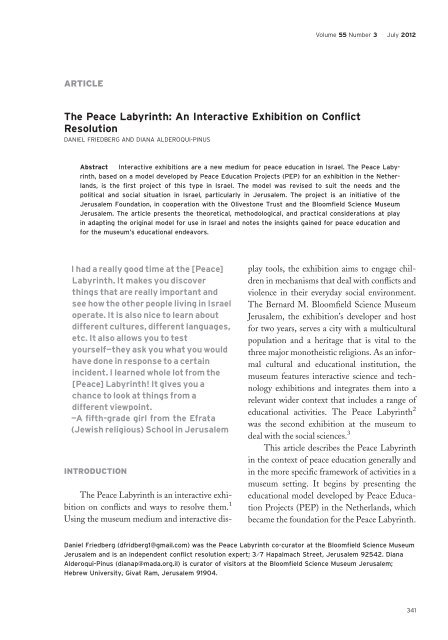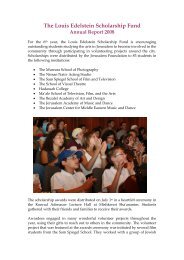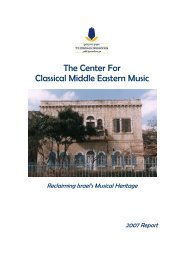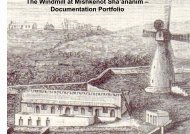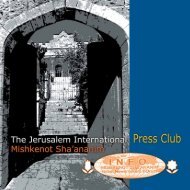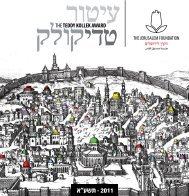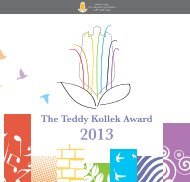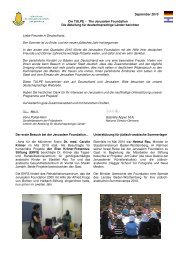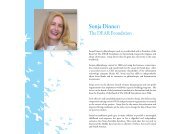The Peace Labyrinth: An Interactive Exhibition on Conflict Resolution
The Peace Labyrinth: An Interactive Exhibition on Conflict Resolution
The Peace Labyrinth: An Interactive Exhibition on Conflict Resolution
Create successful ePaper yourself
Turn your PDF publications into a flip-book with our unique Google optimized e-Paper software.
ARTICLE<br />
<str<strong>on</strong>g>The</str<strong>on</strong>g> <str<strong>on</strong>g>Peace</str<strong>on</strong>g> <str<strong>on</strong>g>Labyrinth</str<strong>on</strong>g>: <str<strong>on</strong>g>An</str<strong>on</strong>g> <str<strong>on</strong>g>Interactive</str<strong>on</strong>g> <str<strong>on</strong>g>Exhibiti<strong>on</strong></str<strong>on</strong>g> <strong>on</strong> C<strong>on</strong>flict<br />
Resoluti<strong>on</strong><br />
DANIEL FRIEDBERG AND DIANA ALDEROQUI-PINUS<br />
Abstract <str<strong>on</strong>g>Interactive</str<strong>on</strong>g> exhibiti<strong>on</strong>s are a new medium for peace educati<strong>on</strong> in Israel. <str<strong>on</strong>g>The</str<strong>on</strong>g> <str<strong>on</strong>g>Peace</str<strong>on</strong>g> <str<strong>on</strong>g>Labyrinth</str<strong>on</strong>g>,<br />
based <strong>on</strong> a model developed by <str<strong>on</strong>g>Peace</str<strong>on</strong>g> Educati<strong>on</strong> Projects (PEP) for an exhibiti<strong>on</strong> in the Netherlands,<br />
is the first project of this type in Israel. <str<strong>on</strong>g>The</str<strong>on</strong>g> model was revised to suit the needs and the<br />
political and social situati<strong>on</strong> in Israel, particularly in Jerusalem. <str<strong>on</strong>g>The</str<strong>on</strong>g> project is an initiative of the<br />
Jerusalem Foundati<strong>on</strong>, in cooperati<strong>on</strong> with the Olivest<strong>on</strong>e Trust and the Bloomfield Science Museum<br />
Jerusalem. <str<strong>on</strong>g>The</str<strong>on</strong>g> article presents the theoretical, methodological, and practical c<strong>on</strong>siderati<strong>on</strong>s at play<br />
in adapting the original model for use in Israel and notes the insights gained for peace educati<strong>on</strong> and<br />
for the museum’s educati<strong>on</strong>al endeavors.<br />
I had a really good time at the [<str<strong>on</strong>g>Peace</str<strong>on</strong>g>]<br />
<str<strong>on</strong>g>Labyrinth</str<strong>on</strong>g>. It makes you discover<br />
things that are really important and<br />
see how the other people living in Israel<br />
operate. It is also nice to learn about<br />
different cultures, different languages,<br />
etc. It also allows you to test<br />
yourself—they ask you what you would<br />
have d<strong>on</strong>e in resp<strong>on</strong>se to a certain<br />
incident. I learned whole lot from the<br />
[<str<strong>on</strong>g>Peace</str<strong>on</strong>g>] <str<strong>on</strong>g>Labyrinth</str<strong>on</strong>g>! It gives you a<br />
chance to look at things from a<br />
different viewpoint.<br />
—A fifth-grade girl from the Efrata<br />
(Jewish religious) School in Jerusalem<br />
INTRODUCTION<br />
<str<strong>on</strong>g>The</str<strong>on</strong>g> <str<strong>on</strong>g>Peace</str<strong>on</strong>g> <str<strong>on</strong>g>Labyrinth</str<strong>on</strong>g> is an interactive exhibiti<strong>on</strong><br />
<strong>on</strong> c<strong>on</strong>flicts and ways to resolve them. 1<br />
Using the museum medium and interactive dis-<br />
Volume 55 Number 3 July 2012<br />
play tools, the exhibiti<strong>on</strong> aims to engage children<br />
in mechanisms that deal with c<strong>on</strong>flicts and<br />
violence in their everyday social envir<strong>on</strong>ment.<br />
<str<strong>on</strong>g>The</str<strong>on</strong>g> Bernard M. Bloomfield Science Museum<br />
Jerusalem, the exhibiti<strong>on</strong>’s developer and host<br />
for two years, serves a city with a multicultural<br />
populati<strong>on</strong> and a heritage that is vital to the<br />
three major m<strong>on</strong>otheistic religi<strong>on</strong>s. As an informal<br />
cultural and educati<strong>on</strong>al instituti<strong>on</strong>, the<br />
museum features interactive science and technology<br />
exhibiti<strong>on</strong>s and integrates them into a<br />
relevant wider c<strong>on</strong>text that includes a range of<br />
educati<strong>on</strong>al activities. <str<strong>on</strong>g>The</str<strong>on</strong>g> <str<strong>on</strong>g>Peace</str<strong>on</strong>g> <str<strong>on</strong>g>Labyrinth</str<strong>on</strong>g> 2<br />
was the sec<strong>on</strong>d exhibiti<strong>on</strong> at the museum to<br />
deal with the social sciences. 3<br />
This article describes the <str<strong>on</strong>g>Peace</str<strong>on</strong>g> <str<strong>on</strong>g>Labyrinth</str<strong>on</strong>g><br />
in the c<strong>on</strong>text of peace educati<strong>on</strong> generally and<br />
in the more specific framework of activities in a<br />
museum setting. It begins by presenting the<br />
educati<strong>on</strong>al model developed by <str<strong>on</strong>g>Peace</str<strong>on</strong>g> Educati<strong>on</strong><br />
Projects (PEP) in the Netherlands, which<br />
became the foundati<strong>on</strong> for the <str<strong>on</strong>g>Peace</str<strong>on</strong>g> <str<strong>on</strong>g>Labyrinth</str<strong>on</strong>g>.<br />
Daniel Friedberg (dfridberg1@gmail.com) was the <str<strong>on</strong>g>Peace</str<strong>on</strong>g> <str<strong>on</strong>g>Labyrinth</str<strong>on</strong>g> co-curator at the Bloomfield Science Museum<br />
Jerusalem and is an independent c<strong>on</strong>flict resoluti<strong>on</strong> expert; 3 ⁄ 7 Hapalmach Street, Jerusalem 92542. Diana<br />
Alderoqui-Pinus (dianap@mada.org.il) is curator of visitors at the Bloomfield Science Museum Jerusalem;<br />
Hebrew University, Givat Ram, Jerusalem 91904.<br />
341
CURATOR THE MUSEUM JOURNAL<br />
It then describes the process of adapting the<br />
exhibiti<strong>on</strong> for use at the Bloomfield Science<br />
Museum Jerusalem, which involved analyzing<br />
the city’s unique set of c<strong>on</strong>flicts and c<strong>on</strong>templating<br />
the use of theoretical c<strong>on</strong>ceptualizati<strong>on</strong><br />
in peace educati<strong>on</strong>. Finally, the article examines<br />
the impact of the exhibiti<strong>on</strong> <strong>on</strong> its visitors and<br />
<strong>on</strong> the museum’s staff.<br />
THE DUTCH MODEL: THE PEACE<br />
FACTORY<br />
<str<strong>on</strong>g>The</str<strong>on</strong>g> <str<strong>on</strong>g>Peace</str<strong>on</strong>g> Factory is an interactive exhibiti<strong>on</strong><br />
that uses the metaphor of a factory to teach<br />
peace educati<strong>on</strong> throughout the Netherlands<br />
and Europe. 4 It is the creati<strong>on</strong> of PEP, a charitable<br />
organizati<strong>on</strong> founded in the Netherlands<br />
in 1993 to develop projects that promote peace,<br />
diversity, c<strong>on</strong>flict resoluti<strong>on</strong>, internati<strong>on</strong>al<br />
cooperati<strong>on</strong>, and harm<strong>on</strong>ious multicultural<br />
societies.<br />
<str<strong>on</strong>g>The</str<strong>on</strong>g> original goal of the <str<strong>on</strong>g>Peace</str<strong>on</strong>g> Factory creators<br />
was to teach the young generati<strong>on</strong> less<strong>on</strong>s<br />
learned from World War II, emphasizing tolerance,<br />
human rights, and c<strong>on</strong>flict resoluti<strong>on</strong> in<br />
peaceful ways. <str<strong>on</strong>g>The</str<strong>on</strong>g> <str<strong>on</strong>g>Peace</str<strong>on</strong>g> Factory illustrates how<br />
war and peace—past, present, and future—<br />
are interc<strong>on</strong>nected. It then shifts the focus to<br />
the pers<strong>on</strong>al beliefs of the visitors (children<br />
aged 12 to 16), who are challenged to examine<br />
their own opini<strong>on</strong>s, choices, and values.<br />
Rather than transmitting informati<strong>on</strong>, the<br />
exhibiti<strong>on</strong> helps visitors to create their own<br />
meaning (Homan and Van Praag 2006). By<br />
tapping into the youngsters’ own identities,<br />
the exhibiti<strong>on</strong> c<strong>on</strong>fr<strong>on</strong>ts them with the c<strong>on</strong>sequences<br />
of their choices in facing everyday<br />
moral dilemmas. Visitors enter the factory in<br />
pairs and are given a ‘‘roadmap to peace’’<br />
indicating a list of exhibits to explore. <str<strong>on</strong>g>The</str<strong>on</strong>g><br />
roadmap also poses questi<strong>on</strong>s, the answers to<br />
which can be found in the course of touring<br />
the exhibiti<strong>on</strong>. <str<strong>on</strong>g>The</str<strong>on</strong>g> Dutch model c<strong>on</strong>tains 64<br />
interactive stati<strong>on</strong>s that focus <strong>on</strong> categories of<br />
social phenomena such as prejudices, scapegoating,<br />
diversity, c<strong>on</strong>flict, forgiveness, repentance,<br />
and refugees.<br />
PEP presented its project at the 2003<br />
European Foundati<strong>on</strong> C<strong>on</strong>ference in Athens.<br />
<str<strong>on</strong>g>The</str<strong>on</strong>g> vice president of the Jerusalem Foundati<strong>on</strong>,<br />
and <strong>on</strong>e of the founders of the Bloomfield<br />
Science Museum, shared his enthusiasm with<br />
the museum staff. Given its interest in exhibiti<strong>on</strong>s<br />
related to the social sciences and its desire<br />
to promote community dialogue, the museum<br />
welcomed the opportunity to mount an interactive<br />
peace educati<strong>on</strong> exhibiti<strong>on</strong> of its own. Preliminary<br />
discussi<strong>on</strong>s addressed the need to<br />
adapt the c<strong>on</strong>tent to the Israeli reality. As a city<br />
of mixed populati<strong>on</strong>s and cultures, Jerusalem is<br />
a nucleus for tensi<strong>on</strong>s in Israel between the Jewish<br />
and Palestinian sectors. Inter-religious, ethnic,<br />
cultural, and class tensi<strong>on</strong>s are part and<br />
parcel of the city and its social dynamic. As a<br />
result, <strong>on</strong>ly a few of its neighborhoods have<br />
mixed populati<strong>on</strong>s. It has two totally separate<br />
school systems, apart from a single bilingual<br />
school where Jewish and Arab children study<br />
together. Because of this separati<strong>on</strong>, chance<br />
encounters between Jews and Arabs as equals<br />
(that is, apart from situati<strong>on</strong>s of service provisi<strong>on</strong>,<br />
employment, and so <strong>on</strong>) are rare, and the<br />
two sectors know very little about each other’s<br />
lives. <str<strong>on</strong>g>The</str<strong>on</strong>g> following secti<strong>on</strong> recounts the major<br />
c<strong>on</strong>siderati<strong>on</strong>s that accompanied the refocusing<br />
process.<br />
THEORETICAL AND METHODOLOGICAL<br />
CONSIDERATIONS<br />
Approaches to <str<strong>on</strong>g>Peace</str<strong>on</strong>g> Educati<strong>on</strong><br />
Societies comprised of numerous ethnic,<br />
religious, and class-based groups are c<strong>on</strong>-<br />
342 Article: <str<strong>on</strong>g>The</str<strong>on</strong>g> <str<strong>on</strong>g>Peace</str<strong>on</strong>g> <str<strong>on</strong>g>Labyrinth</str<strong>on</strong>g>: <str<strong>on</strong>g>An</str<strong>on</strong>g> <str<strong>on</strong>g>Interactive</str<strong>on</strong>g> <str<strong>on</strong>g>Exhibiti<strong>on</strong></str<strong>on</strong>g> <strong>on</strong> C<strong>on</strong>flict Resoluti<strong>on</strong>
stantly c<strong>on</strong>fr<strong>on</strong>ted with intergroup biases, such<br />
as stereotypes and prejudices about out-groups<br />
and preferences for the in-group. One effort<br />
by educators to address these sorts of biases,<br />
which can deteriorate into c<strong>on</strong>flict and even<br />
violence, is the <str<strong>on</strong>g>Peace</str<strong>on</strong>g> Educati<strong>on</strong> movement<br />
initiated in the latter half of the last century.<br />
Galtung differentiates between two types of<br />
peace (1969). One is a positive peace of cooperati<strong>on</strong><br />
and harm<strong>on</strong>y. Educati<strong>on</strong> for positive<br />
peace is more prevalent in regi<strong>on</strong>s with no<br />
active, violent c<strong>on</strong>flict (the Netherlands, for<br />
example), and it tends to be theoretical in nature,<br />
with no reference to a particular dispute.<br />
<str<strong>on</strong>g>The</str<strong>on</strong>g> sec<strong>on</strong>d type of peace, negative peace, is<br />
characterized by an absence of violence or<br />
hostility. Educati<strong>on</strong> for negative peace is more<br />
prevalent in c<strong>on</strong>flict areas such as Israel and<br />
Northern Ireland.<br />
When setting goals for <str<strong>on</strong>g>Peace</str<strong>on</strong>g> Educati<strong>on</strong><br />
activities in a c<strong>on</strong>flict area, Salom<strong>on</strong> points to two<br />
types of change that peace educati<strong>on</strong> aims to generate<br />
(2004). One is individual change, focused<br />
<strong>on</strong> developing communicati<strong>on</strong> and c<strong>on</strong>flict-resoluti<strong>on</strong><br />
skills, and the other, at the societal level,<br />
targets opini<strong>on</strong>s, stereotypes, and prejudices<br />
about the ‘‘other.’’ When we made the necessary<br />
adaptati<strong>on</strong>s to the Dutch original exhibit, we<br />
adopted the first—individual focus—for the skills<br />
development goals, and the sec<strong>on</strong>d—the societal<br />
level—for the awareness related goals.<br />
In translating these principles into practice, a<br />
key approach to peace educati<strong>on</strong> that has taken<br />
root in Israel since the mid 1970s c<strong>on</strong>sists of facilitated<br />
encounters between individuals in c<strong>on</strong>flict at<br />
specified times and locati<strong>on</strong>s. <str<strong>on</strong>g>The</str<strong>on</strong>g> frequent occurrence<br />
of these encounters over the past 30 years 5<br />
indicates that the underlying c<strong>on</strong>cept is still<br />
c<strong>on</strong>sidered an effective means of bringing people<br />
together and promoting rec<strong>on</strong>ciliati<strong>on</strong>, peace, and<br />
partnership am<strong>on</strong>g Israel’s social sectors, particularly<br />
between Jews and Palestinians.<br />
Several group encounter models are used in<br />
Israel, am<strong>on</strong>g them models of cooperati<strong>on</strong> and<br />
informati<strong>on</strong> transfer, negotiati<strong>on</strong> models, and<br />
c<strong>on</strong>flict management models (Maoz 2000).<br />
Here we menti<strong>on</strong> two frequently employed dialogue<br />
group models in the country that are also<br />
relevant to our purposes: the c<strong>on</strong>tact approach<br />
and the intergroup approach.<br />
<str<strong>on</strong>g>The</str<strong>on</strong>g> c<strong>on</strong>tact approach<br />
<str<strong>on</strong>g>The</str<strong>on</strong>g> c<strong>on</strong>tact hypothesis holds that parties<br />
in c<strong>on</strong>flict nurture distorted percepti<strong>on</strong>s and<br />
hostility because they are not in direct c<strong>on</strong>tact<br />
and their members not mutually acquainted. In<br />
a c<strong>on</strong>flict situati<strong>on</strong>, then, c<strong>on</strong>tact and acquaintance<br />
can generate b<strong>on</strong>ds of friendship, lessen<br />
prejudice, and improve attitudes. Once the<br />
members of the two groups meet, they tend,<br />
so<strong>on</strong>er or later, to accept the situati<strong>on</strong> and<br />
become accustomed to it (Allport 1958; Amir<br />
1976).<br />
<str<strong>on</strong>g>The</str<strong>on</strong>g> intergroup approach<br />
Volume 55 Number 3 July 2012<br />
While the c<strong>on</strong>tact hypothesis views the<br />
group encounter as a means of lessening the participants’<br />
hostility and intergroup biases, the intergroup<br />
approach developed in the 1990s<br />
highlights explorati<strong>on</strong> of self-identity and<br />
methods of dealing with the reality of c<strong>on</strong>flict<br />
between peoples (S<strong>on</strong>nenschein and Halabi in<br />
Halabi 2004). 6 In this sense, the encounter with<br />
other identity groups serves the participants <strong>on</strong>ly<br />
as a catalyst for an intragroup identity re-examinati<strong>on</strong><br />
and redefiniti<strong>on</strong> of the group identity.<br />
One of the focal points of the intergroup<br />
approach is that it empowers the participants by<br />
allowing them—<strong>on</strong> their own, without guidance—to<br />
examine how their identities enter<br />
into the c<strong>on</strong>flicts in which they are engaged in<br />
their lives. This empowerment is crucial, and is<br />
Daniel Friedberg and Diana Alderoqui-Pinus 343
CURATOR THE MUSEUM JOURNAL<br />
based <strong>on</strong> the assumpti<strong>on</strong> that <strong>on</strong>ly by discovering<br />
for ourselves the mechanisms at work in<br />
c<strong>on</strong>flict situati<strong>on</strong>s can we successfully change<br />
them, c<strong>on</strong>sciously and willingly.<br />
Since explorati<strong>on</strong> of <strong>on</strong>e’s self-identity is<br />
the central feature of the intergroup approach,<br />
the unique type of facilitati<strong>on</strong> it created is the<br />
<strong>on</strong>e-sided (homogeneous) workshop. This technique<br />
may appear to c<strong>on</strong>tradict the noti<strong>on</strong> of a<br />
joint meeting as a primary tool for encouraging<br />
dialogue between groups in c<strong>on</strong>flict. However,<br />
the intergroup approach—with its emphasis <strong>on</strong><br />
self-identity, the relatively safe space it offers,<br />
and the openness it encourages—often serves to<br />
spark dialogue am<strong>on</strong>g participants and lead<br />
them to examine their opini<strong>on</strong>s.<br />
<str<strong>on</strong>g>The</str<strong>on</strong>g>se two last principles of the inter-group<br />
approach led us to operate the exhibiti<strong>on</strong> for<br />
<strong>on</strong>e group at a time, with separate sessi<strong>on</strong>s for<br />
Hebrew- and Arabic-speaking groups and with<br />
as little guidance as possible during the work<br />
with the interactive exhibits.<br />
Previous <str<strong>on</strong>g>Peace</str<strong>on</strong>g> Educati<strong>on</strong> activities at the<br />
Bloomfield Science Museum Jerusalem<br />
Since its incepti<strong>on</strong>, the Bloomfield Science<br />
Museum has hosted encounters based <strong>on</strong> the<br />
c<strong>on</strong>tact hypothesis. <str<strong>on</strong>g>The</str<strong>on</strong>g> museum welcomes all<br />
visitors, adults and children, and as part of its<br />
commitment to every sector of the populati<strong>on</strong>, it<br />
displays all exhibiti<strong>on</strong> labels and texts in three<br />
languages: Hebrew, Arabic, and English. <str<strong>on</strong>g>Exhibiti<strong>on</strong></str<strong>on</strong>g>s<br />
and activities are adapted to classroom curriculums<br />
across the board, with special programs<br />
appropriate for Arab and ultra-Orthodox Jewish<br />
schoolchildren. Field trips are c<strong>on</strong>ducted in Arabic<br />
<strong>on</strong> a regular basis, and some of the museum’s<br />
guides are bilingual, native-Arabic speakers.<br />
Bilingual staff members provide important cultural<br />
links to the communities and are able to<br />
overcome communicati<strong>on</strong> gaps with ease.<br />
Bloomfield Science Museum also c<strong>on</strong>ducts<br />
joint programs for Jewish and Arab children. At<br />
its <strong>on</strong>-site summer camps, launched five years<br />
ago, 30 children, ages nine to 11 (15 per group),<br />
gather for 10 days of science workshops, art<br />
projects, and sports activities. <str<strong>on</strong>g>The</str<strong>on</strong>g> groups, each<br />
with its own facilitator, functi<strong>on</strong> both separately<br />
and jointly. Despite language barriers, the children<br />
manage to work and play together. <str<strong>on</strong>g>The</str<strong>on</strong>g><br />
limitati<strong>on</strong> of this approach is that the children<br />
do not necessarily get to know each other or to<br />
c<strong>on</strong>fr<strong>on</strong>t their own views regarding the other<br />
group. <str<strong>on</strong>g>The</str<strong>on</strong>g> topics discussed in these activities<br />
have had no direct c<strong>on</strong>necti<strong>on</strong> to the Israel-<br />
Arab c<strong>on</strong>flict; they related to science, and any<br />
c<strong>on</strong>necti<strong>on</strong> with cooperati<strong>on</strong> and coexistence<br />
was indirect. <str<strong>on</strong>g>The</str<strong>on</strong>g>y have not addressed issues<br />
such as inequality or power relati<strong>on</strong>s, and in<br />
theory and practice they therefore typify the<br />
c<strong>on</strong>tact approach. Given the nature of the activity,<br />
participati<strong>on</strong> is limited to a relatively small<br />
number of children (between 20 and 40 each<br />
year).<br />
To widen the impact, the planners of the<br />
<str<strong>on</strong>g>Peace</str<strong>on</strong>g> <str<strong>on</strong>g>Labyrinth</str<strong>on</strong>g> realized that they needed to<br />
expand the framework as well as the involvement<br />
of the museum by adopting elements from<br />
the intergroup approach, particularly homogeneous<br />
group work and direct engagement with<br />
c<strong>on</strong>flict related issues.<br />
<str<strong>on</strong>g>The</str<strong>on</strong>g> interactive display as a new medium<br />
for peace educati<strong>on</strong><br />
<str<strong>on</strong>g>The</str<strong>on</strong>g> previously described approaches to<br />
peace educati<strong>on</strong> rely mainly <strong>on</strong> the medium of<br />
the workshop. <str<strong>on</strong>g>The</str<strong>on</strong>g> primary tools, therefore, are<br />
discussi<strong>on</strong>, reflexive thinking, and activity. <str<strong>on</strong>g>The</str<strong>on</strong>g><br />
Dutch model that formed the basis for the<br />
Bloomfield Science Museum exhibiti<strong>on</strong> makes<br />
innovative use of museums for peace educati<strong>on</strong>.<br />
Most of the activities center <strong>on</strong> interactive<br />
344 Article: <str<strong>on</strong>g>The</str<strong>on</strong>g> <str<strong>on</strong>g>Peace</str<strong>on</strong>g> <str<strong>on</strong>g>Labyrinth</str<strong>on</strong>g>: <str<strong>on</strong>g>An</str<strong>on</strong>g> <str<strong>on</strong>g>Interactive</str<strong>on</strong>g> <str<strong>on</strong>g>Exhibiti<strong>on</strong></str<strong>on</strong>g> <strong>on</strong> C<strong>on</strong>flict Resoluti<strong>on</strong>
displays that challenge visitors by posing questi<strong>on</strong>s<br />
appropriate to their ages, languages, cultural<br />
backgrounds, and daily lives.<br />
One advantage of the museum setting is<br />
the opportunity it offers for individual empowerment<br />
(of students, in this case) through independent<br />
activity at an exhibiti<strong>on</strong>. Visitors are<br />
free to give full and undisturbed expressi<strong>on</strong> to<br />
their thinking and analytical abilities. To allow<br />
for some possibility of joint learning, the students<br />
work their way through the exhibiti<strong>on</strong> in<br />
pairs, and each task they encounter offers an<br />
opportunity to deliberate and learn from each<br />
other. This is the model used for the Bloomfield<br />
Science Museum exhibiti<strong>on</strong> in Jerusalem, with<br />
several changes in c<strong>on</strong>tent required for adaptati<strong>on</strong><br />
to the Israeli reality.<br />
THE PROCESS OF ADAPTING THE<br />
ORIGINAL EXHIBITION TO ISRAELI<br />
SOCIETY<br />
<str<strong>on</strong>g>The</str<strong>on</strong>g> Dutch model deals directly with c<strong>on</strong>tent<br />
related to c<strong>on</strong>flicts, culture, and tolerance.<br />
In planning the c<strong>on</strong>tent for the exhibiti<strong>on</strong> in<br />
Israel, we organized an educati<strong>on</strong>al advisory<br />
committee c<strong>on</strong>sisting of Jewish and Arab elementary<br />
school principals and teachers in Jerusalem,<br />
other professi<strong>on</strong>al educators, and<br />
professi<strong>on</strong>als in the field of social project management.<br />
Both Jewish and Arab educators c<strong>on</strong>sidered<br />
some of the original topics (such as war<br />
refugees) so politically sensitive in the Israeli<br />
climate that they might alienate rather than<br />
attract the exhibiti<strong>on</strong>’s target populati<strong>on</strong>s.<br />
<str<strong>on</strong>g>An</str<strong>on</strong>g> important questi<strong>on</strong> arose in the process<br />
of deciding whether to create homogeneous<br />
versus heterogeneous (mixed Israeli-Palestinian)<br />
groups of visitors to the exhibiti<strong>on</strong>. Intuitively,<br />
<strong>on</strong>e would argue that an inter-group<br />
incounter is necessary for our purpose of peace<br />
educati<strong>on</strong>. Yet, we opted for homogeneous<br />
Volume 55 Number 3 July 2012<br />
groups in order to give visitors a chance to<br />
express their true views, without fear of criticism,<br />
and be open to other points of view within<br />
their own groups. <str<strong>on</strong>g>An</str<strong>on</strong>g>other advantage of homogeneous<br />
groups is that in any mixed forum of<br />
Jews and Arabs in Israel, participants gravitate<br />
toward the subject of the political and religious<br />
‘‘other.’’ <str<strong>on</strong>g>An</str<strong>on</strong>g>d totally different (n<strong>on</strong>-political)<br />
realms of ‘‘otherness’’—such as male-female<br />
relati<strong>on</strong>ships, or the needs of special populati<strong>on</strong>s—are<br />
present in the minds of many children,<br />
particularly those at the ages of the<br />
exhibiti<strong>on</strong> visitors.<br />
<str<strong>on</strong>g>The</str<strong>on</strong>g> name of the exhibiti<strong>on</strong> was also <strong>on</strong>e of<br />
the main c<strong>on</strong>cerns of the educati<strong>on</strong>al committee.<br />
Many of us were uncomfortable with the<br />
original name, ‘‘<str<strong>on</strong>g>The</str<strong>on</strong>g> <str<strong>on</strong>g>Peace</str<strong>on</strong>g> Factory.’’ However,<br />
out of commitment to the Dutch exhibiti<strong>on</strong>, we<br />
looked for a name which would remind us of<br />
the original exhibiti<strong>on</strong>. Eli Shapiro, the exhibiti<strong>on</strong><br />
designer, eventually raised the idea of ‘‘<str<strong>on</strong>g>The</str<strong>on</strong>g><br />
<str<strong>on</strong>g>Peace</str<strong>on</strong>g> <str<strong>on</strong>g>Labyrinth</str<strong>on</strong>g>’’ as both a metaphor for the<br />
challenge of seeking and achieving peace and a<br />
practical model for the exhibiti<strong>on</strong>’s c<strong>on</strong>structi<strong>on</strong>.<br />
Since the <str<strong>on</strong>g>Peace</str<strong>on</strong>g> <str<strong>on</strong>g>Labyrinth</str<strong>on</strong>g> deals with<br />
peace in daily life rather than in relati<strong>on</strong> to war,<br />
it was important for us to emphasize to visitors<br />
that peace defines the way we interact with our<br />
peers, teachers, and parents and from these<br />
interacti<strong>on</strong>s we can learn how to make peace<br />
with other peoples and nati<strong>on</strong>s.<br />
<str<strong>on</strong>g>The</str<strong>on</strong>g> project staff was guided by the following<br />
principles in developing the exhibiti<strong>on</strong>:<br />
Redefiniti<strong>on</strong> of the exhibiti<strong>on</strong> goals<br />
As an instituti<strong>on</strong> with a curatorial team,<br />
the museum’s interest was to enhance the structural,<br />
museological approach to the exhibiti<strong>on</strong>.<br />
<str<strong>on</strong>g>The</str<strong>on</strong>g> project staff decided to reduce the multitude<br />
of displays (64) and subjects in the Dutch<br />
model, preferring instead to address general<br />
Daniel Friedberg and Diana Alderoqui-Pinus 345
CURATOR THE MUSEUM JOURNAL<br />
ideas in clusters of exhibits. Given the needs of<br />
the country’s educati<strong>on</strong> system and the feedback<br />
provided by the educati<strong>on</strong>al advisory committee,<br />
the staff decided that the Jerusalem exhibiti<strong>on</strong><br />
would focus <strong>on</strong> c<strong>on</strong>flict resoluti<strong>on</strong>. Three<br />
main goals were set:<br />
• Strengthen children’s communicati<strong>on</strong><br />
skills<br />
• Increase self-awareness in situati<strong>on</strong>s of<br />
c<strong>on</strong>flict<br />
• Offer children skills to deal with c<strong>on</strong>flict<br />
Focus <strong>on</strong> interpers<strong>on</strong>al and school-related<br />
dimensi<strong>on</strong>s of c<strong>on</strong>flict<br />
As menti<strong>on</strong>ed above, the original model<br />
addresses sensitive subjects such as war, refugees,<br />
and political pris<strong>on</strong>ers. In Jerusalem, it<br />
was felt that inclusi<strong>on</strong> of these subjects would<br />
deter many schools, both Jewish and Arab, from<br />
visiting the exhibiti<strong>on</strong>. In assessing what the<br />
project could c<strong>on</strong>tribute to the local educati<strong>on</strong><br />
system, the planners identified an acute need<br />
for tools that can help diminish internal violence<br />
and interpers<strong>on</strong>al c<strong>on</strong>flict. <str<strong>on</strong>g>The</str<strong>on</strong>g>y gave priority<br />
to this practical need, rather than to<br />
addressing broad political and social c<strong>on</strong>flicts.<br />
<str<strong>on</strong>g>The</str<strong>on</strong>g>y also aimed to train visitors to deal with<br />
political and social issues as children grow up.<br />
<str<strong>on</strong>g>The</str<strong>on</strong>g> focus in Israel, therefore, became c<strong>on</strong>flict<br />
in the children’s immediate surroundings—the<br />
interpers<strong>on</strong>al and school envir<strong>on</strong>ments.<br />
Cultural sensitivity, representati<strong>on</strong> and<br />
respect<br />
As an initial goal of the project, we proposed<br />
that equal numbers of Jewish and Arab<br />
children would visit the exhibiti<strong>on</strong> during its<br />
run in Jerusalem. <str<strong>on</strong>g>The</str<strong>on</strong>g> decisi<strong>on</strong> to employ an<br />
egalitarian, joint Jewish and Arab management<br />
model was based <strong>on</strong> the understanding that<br />
both groups needed to be represented at all levels<br />
of planning and implementati<strong>on</strong>. In promoting<br />
acceptance of the culture and values of all<br />
groups that visit the museum, the exhibiti<strong>on</strong><br />
delivers a clear message in support of universal<br />
humanistic principles such as equal rights.<br />
One inherent transmissi<strong>on</strong> of this message<br />
in the exhibiti<strong>on</strong> is the use of Hebrew and Arabic<br />
side by side and in equal measure. Additi<strong>on</strong>ally,<br />
an entire display is devoted to the c<strong>on</strong>necti<strong>on</strong><br />
between the two languages.<br />
Utilizati<strong>on</strong> of the Science Museum’s<br />
technological knowledge and experience<br />
In light of the museum’s extensive experience<br />
in developing high level interactive exhibits,<br />
it was clear during the planning stages that<br />
the <str<strong>on</strong>g>Peace</str<strong>on</strong>g> <str<strong>on</strong>g>Labyrinth</str<strong>on</strong>g> would rely <strong>on</strong> the<br />
museum’s infrastructure and technological<br />
know how. Indeed, ideas inspired by the physical<br />
and graphic design of previous exhibits, and<br />
utilizati<strong>on</strong> of elements from other museum displays<br />
(am<strong>on</strong>g them the DNA exhibit, described<br />
below), improved the original model significantly.<br />
Many of these elements have been<br />
adopted in new versi<strong>on</strong>s of the exhibiti<strong>on</strong> by our<br />
Dutch colleagues in Europe.<br />
DESCRIPTION OF THE FINAL PRODUCT<br />
Exhibit design<br />
<str<strong>on</strong>g>The</str<strong>on</strong>g> exhibiti<strong>on</strong> is designed as a maze with<br />
40 numbered displays. Each class arrives<br />
divided into pairs, and each pair is assigned a<br />
place from which it begins to work its way<br />
through all the numbers c<strong>on</strong>secutively, until it<br />
returns to its starting point. <str<strong>on</strong>g>The</str<strong>on</strong>g> visitors guide<br />
(<str<strong>on</strong>g>Labyrinth</str<strong>on</strong>g> Map) c<strong>on</strong>tains a task for each<br />
346 Article: <str<strong>on</strong>g>The</str<strong>on</strong>g> <str<strong>on</strong>g>Peace</str<strong>on</strong>g> <str<strong>on</strong>g>Labyrinth</str<strong>on</strong>g>: <str<strong>on</strong>g>An</str<strong>on</strong>g> <str<strong>on</strong>g>Interactive</str<strong>on</strong>g> <str<strong>on</strong>g>Exhibiti<strong>on</strong></str<strong>on</strong>g> <strong>on</strong> C<strong>on</strong>flict Resoluti<strong>on</strong>
display. Interacti<strong>on</strong> with the exhibiti<strong>on</strong> is varied<br />
and includes riddles to be solved, dilemmas to<br />
be discussed, and joint decisi<strong>on</strong>s to be made.<br />
<str<strong>on</strong>g>The</str<strong>on</strong>g> planned time frame for the children’s<br />
museological experience was roughly <strong>on</strong>e hour.<br />
<str<strong>on</strong>g>The</str<strong>on</strong>g> actual visit time ranges between 45 minutes<br />
and an hour, according to the children’s<br />
ages and levels of comprehensi<strong>on</strong>.<br />
To organize the distributi<strong>on</strong> of a school<br />
group (30 children <strong>on</strong> average), entry points<br />
were predetermined: three or four for each cluster,<br />
15 in all. For example, the c<strong>on</strong>flict resoluti<strong>on</strong><br />
cluster has three entry points: forgiveness;<br />
increasing scarce resources (enlarging the pie);<br />
and expressing dislike. Though the exhibiti<strong>on</strong> is<br />
linear in design—visitors interact with the 40<br />
exhibits starting at their entry point and ending<br />
with the first exhibit they encountered—we can<br />
better describe the visitors’ experience as several<br />
sequences that provide a comprehensive whole.<br />
<str<strong>on</strong>g>The</str<strong>on</strong>g> linearity of the visit is suited to the<br />
organizati<strong>on</strong>al needs of the group; it does not<br />
resemble exhibiti<strong>on</strong>s that have <strong>on</strong>e entry and<br />
<strong>on</strong>e exit and pose closed questi<strong>on</strong>s with <strong>on</strong>ly<br />
<strong>on</strong>e answer. Most of the <str<strong>on</strong>g>Peace</str<strong>on</strong>g> <str<strong>on</strong>g>Labyrinth</str<strong>on</strong>g> tasks<br />
do not have right or wr<strong>on</strong>g answers, and interactivity<br />
is varied. Children are offered a choice<br />
of opti<strong>on</strong>s, based <strong>on</strong> their beliefs and values.<br />
<str<strong>on</strong>g>The</str<strong>on</strong>g>y can state whether they agree or disagree<br />
with some statements, tell their stories or solve<br />
puzzles, and compare their answers with those<br />
of their friends.<br />
For example, in the Rights exhibit the children<br />
are invited to read the statements <strong>on</strong> a side<br />
panel and indicate by turning a sign if they agree<br />
or disagree: All human beings are equal. Both<br />
tall and short children can play <strong>on</strong> the school<br />
basketball team. All human beings are different.<br />
Both boys and girls can play soccer. You must<br />
treat all people equally.<br />
In the Violence in School display the children<br />
are invited to rate areas in their school—<br />
entrance, stairs, classrooms, bathrooms, or<br />
playground according to the amount of violence<br />
in them.<br />
As in the Dutch model, most displays allow<br />
for more than <strong>on</strong>e answer in order to help visitors<br />
find their own answers. Only a few displays<br />
offer definiti<strong>on</strong>s (for example, what stereotypes<br />
are).<br />
Exhibit c<strong>on</strong>tent<br />
Volume 55 Number 3 July 2012<br />
In accordance with Gavriel Salom<strong>on</strong>’s two<br />
approaches to peace educati<strong>on</strong> in c<strong>on</strong>flict<br />
areas 7 —interpers<strong>on</strong>al communicati<strong>on</strong> and c<strong>on</strong>flict<br />
resoluti<strong>on</strong> skills, and recogniti<strong>on</strong> and<br />
acceptance of the ‘‘other’’ (2004)—the planning<br />
process for the <str<strong>on</strong>g>Peace</str<strong>on</strong>g> <str<strong>on</strong>g>Labyrinth</str<strong>on</strong>g> mapped the<br />
exhibiti<strong>on</strong> c<strong>on</strong>tent in four clusters 8 :<br />
<str<strong>on</strong>g>The</str<strong>on</strong>g> equal and the different: C<strong>on</strong>flict erupts<br />
or develops when we discover differences<br />
between ourselves and others. In this secti<strong>on</strong>,<br />
visitors process a ‘‘difference’’ and examine how<br />
it is possible to both accept it and simultaneously<br />
preserve the value of equality. For<br />
example, the DNA display was based <strong>on</strong> material<br />
featured in a museum exhibit <strong>on</strong> biology<br />
and genetics. Variati<strong>on</strong>s <strong>on</strong> the display have<br />
appeared at other science museums, and all are<br />
designed to illustrate for visitors the traits that<br />
all human beings share and the traits that are<br />
unique to each individual. Visitors answer 10<br />
questi<strong>on</strong>s about their physical characteristics by<br />
choosing <strong>on</strong>e of two opti<strong>on</strong>s (dark or light hair,<br />
for example). Once they complete their ‘‘identity<br />
profile,’’ they receive feedback sheets showing<br />
the number of exhibiti<strong>on</strong> visitors who share<br />
each of the traits marked, and the number of<br />
visitors who share all the traits marked. <str<strong>on</strong>g>The</str<strong>on</strong>g> larger<br />
the total number of visitors, the greater the<br />
number of visitors sharing each <strong>on</strong>e of the traits<br />
(given the fact that <strong>on</strong>ly two choices were<br />
listed), while the number of visitors sharing all<br />
Daniel Friedberg and Diana Alderoqui-Pinus 347
CURATOR THE MUSEUM JOURNAL<br />
the traits remains c<strong>on</strong>sistently quite low. <str<strong>on</strong>g>The</str<strong>on</strong>g><br />
feedback visitors get is striking evidence of the<br />
uniqueness of each individual. Once the visitors<br />
are shown what makes them unique (with no<br />
value judgment made about their characteristics),<br />
they are ready to discuss, at a later stage,<br />
the issue of different but equal as it applies to<br />
people.<br />
Observati<strong>on</strong> and interpretati<strong>on</strong>: Knowing<br />
that all people are unique, we discover that<br />
when different people witness certain events<br />
they understand and interpret them in different<br />
ways. Prejudice is an example of social interpretati<strong>on</strong><br />
that creates and perpetuates c<strong>on</strong>flict. <str<strong>on</strong>g>The</str<strong>on</strong>g><br />
<str<strong>on</strong>g>Peace</str<strong>on</strong>g> <str<strong>on</strong>g>Labyrinth</str<strong>on</strong>g>’s Rashom<strong>on</strong> display, based <strong>on</strong><br />
a museum exhibiti<strong>on</strong> <strong>on</strong> percepti<strong>on</strong>, records the<br />
resp<strong>on</strong>ses of two or three visitors who are<br />
exposed to informati<strong>on</strong> that they are led to<br />
interpret in different ways (as in the Akira<br />
Kurosawa film of the same name). <str<strong>on</strong>g>The</str<strong>on</strong>g> display<br />
features a short film showing a boy who enters a<br />
bakery, buys a birthday cake, and walks to the<br />
park with it. <str<strong>on</strong>g>The</str<strong>on</strong>g> whole time, we see a group of<br />
children following him and getting increasingly<br />
closer. <str<strong>on</strong>g>The</str<strong>on</strong>g> film stops abruptly, and the visitors<br />
are asked what they think will happen next.<br />
Will the children surprise him with a party, or<br />
will they attack him from behind and ruin his<br />
birthday? What the pair or threesome of visitors<br />
do not know is that as they were watching, each<br />
heard a different musical soundtrack—<strong>on</strong>e<br />
pleasant and lighthearted, and the other discordant<br />
and scary. <str<strong>on</strong>g>The</str<strong>on</strong>g>y discover that their predicti<strong>on</strong>s<br />
for the next scene are different, and they<br />
are puzzled as to why. (This was, indeed, what<br />
happened in each case.) <str<strong>on</strong>g>The</str<strong>on</strong>g> visitors are then<br />
shown two alternative endings, with no clue as<br />
to which <strong>on</strong>e is ‘‘real.’’ In other words, any interpretati<strong>on</strong><br />
is seen as legitimate, given that it is<br />
based <strong>on</strong> partial or different informati<strong>on</strong>.<br />
C<strong>on</strong>flict resoluti<strong>on</strong>: In this secti<strong>on</strong>, the visitors<br />
learn about different types of violence, c<strong>on</strong>-<br />
sult with each other about how to reduce<br />
violence at school, and acquire skills for resolving<br />
differences. <str<strong>on</strong>g>The</str<strong>on</strong>g> display examines the visitors’<br />
decisi<strong>on</strong>-making processes in c<strong>on</strong>flict<br />
situati<strong>on</strong>s and shows them the benefit of taking<br />
into account relevant c<strong>on</strong>siderati<strong>on</strong>s and c<strong>on</strong>sequences.<br />
<str<strong>on</strong>g>The</str<strong>on</strong>g>y are c<strong>on</strong>fr<strong>on</strong>ted with the following<br />
situati<strong>on</strong>: Kids in class are bullying <strong>on</strong>e of<br />
your friends, and you want them to stop. You<br />
have four possible courses of acti<strong>on</strong>, each of<br />
which produces four-way c<strong>on</strong>sequences: for<br />
you, for your friend, for your relati<strong>on</strong>ship, and<br />
for the future course of events. All possible outcomes<br />
are presented to visitors in the form of a<br />
table (see table 1 here).<br />
<str<strong>on</strong>g>The</str<strong>on</strong>g> visitors realize that they must pay a<br />
price no matter which acti<strong>on</strong> they choose—<strong>on</strong>e<br />
that affects themselves, their friend’s safety, or<br />
their relati<strong>on</strong>ship with the friend. Once visitors<br />
are aware of the cost and benefit of each opti<strong>on</strong>,<br />
they can make educated decisi<strong>on</strong>s and take<br />
resp<strong>on</strong>sibility for the c<strong>on</strong>sequences. <str<strong>on</strong>g>The</str<strong>on</strong>g>n a follow-up<br />
questi<strong>on</strong> is posed: In choosing how to<br />
act, what was your most important c<strong>on</strong>siderati<strong>on</strong>—what<br />
will happen to you, what will happen<br />
to your friend, how the choice will affect<br />
your relati<strong>on</strong>ship, or what the end result will<br />
be? <str<strong>on</strong>g>The</str<strong>on</strong>g> display is based <strong>on</strong> a similar <strong>on</strong>e in the<br />
Dutch model. While the Netherlands exhibiti<strong>on</strong><br />
showed visitors a desirable soluti<strong>on</strong>, however,<br />
we chose to display all possible soluti<strong>on</strong>s<br />
al<strong>on</strong>g with their c<strong>on</strong>sequences in order to highlight<br />
the complexity of this sort of decisi<strong>on</strong> in<br />
real life.<br />
Communicati<strong>on</strong> and rights: Visitors to the<br />
exhibiti<strong>on</strong> learn about the similarity between<br />
the Hebrew and Arabic languages and the<br />
importance of communicati<strong>on</strong> between people.<br />
<str<strong>on</strong>g>The</str<strong>on</strong>g>y also learn about the basic rights that each<br />
pers<strong>on</strong> (and each child) has, and the need to<br />
respect and defend those rights. <str<strong>on</strong>g>The</str<strong>on</strong>g> dicti<strong>on</strong>ary<br />
display in the <str<strong>on</strong>g>Peace</str<strong>on</strong>g> <str<strong>on</strong>g>Labyrinth</str<strong>on</strong>g> is designed to<br />
348 Article: <str<strong>on</strong>g>The</str<strong>on</strong>g> <str<strong>on</strong>g>Peace</str<strong>on</strong>g> <str<strong>on</strong>g>Labyrinth</str<strong>on</strong>g>: <str<strong>on</strong>g>An</str<strong>on</strong>g> <str<strong>on</strong>g>Interactive</str<strong>on</strong>g> <str<strong>on</strong>g>Exhibiti<strong>on</strong></str<strong>on</strong>g> <strong>on</strong> C<strong>on</strong>flict Resoluti<strong>on</strong>
Table 1:<br />
Text for the c<strong>on</strong>flict resoluti<strong>on</strong> display<br />
What will be the<br />
result?<br />
<str<strong>on</strong>g>The</str<strong>on</strong>g> bullying will<br />
c<strong>on</strong>tinue.<br />
<str<strong>on</strong>g>The</str<strong>on</strong>g> bullying might<br />
end.<br />
I feel sorry for<br />
him, but the<br />
bullying will<br />
c<strong>on</strong>tinue.<br />
<str<strong>on</strong>g>The</str<strong>on</strong>g> bullying might<br />
end.<br />
What will happen<br />
to our<br />
relati<strong>on</strong>ship?<br />
Our relati<strong>on</strong>ship<br />
will suffer.<br />
Our relati<strong>on</strong>ship<br />
will grow a lot<br />
str<strong>on</strong>ger.<br />
Our relati<strong>on</strong>ship<br />
will stay the<br />
same and maybe<br />
improve.<br />
Our relati<strong>on</strong>ship<br />
will grow str<strong>on</strong>ger.<br />
make Arabic accessible to Hebrew speakers,<br />
and vice versa. In the Jerusalem reality, the<br />
majority of the city’s children do not speak the<br />
other’s language, despite the geographical proximity<br />
of the populati<strong>on</strong>s and the fact that their<br />
languages are quite similar. <str<strong>on</strong>g>The</str<strong>on</strong>g> dicti<strong>on</strong>ary display<br />
presents two sets of 10 words, in Arabic<br />
and Hebrew, and visitors are asked to match<br />
them in random fashi<strong>on</strong>, as they would in a<br />
memory game. <str<strong>on</strong>g>The</str<strong>on</strong>g> similarity between the languages<br />
makes this a simple task and leaves visitors<br />
with the sense that the other language is<br />
more accessible and easier to understand than<br />
they had thought.<br />
EVALUATION OF THE PROJECT<br />
<str<strong>on</strong>g>The</str<strong>on</strong>g> project staff evaluated the project over<br />
the course of two years (with particular emphasis<br />
<strong>on</strong> the sec<strong>on</strong>d year) to improve the exhibiti<strong>on</strong><br />
while it was still being featured in<br />
What will happen<br />
to my friend?<br />
He’ll c<strong>on</strong>tinue to<br />
suffer.<br />
Maybe he’ll<br />
c<strong>on</strong>tinue to<br />
suffer and maybe<br />
he w<strong>on</strong>’t.<br />
He’ll c<strong>on</strong>tinue to<br />
suffer.<br />
Maybe he’ll<br />
c<strong>on</strong>tinue to<br />
suffer and maybe<br />
he w<strong>on</strong>’t.<br />
What will happen<br />
to me?<br />
Jerusalem, and to draw useful c<strong>on</strong>clusi<strong>on</strong>s for<br />
mounting it at other sites in Israel. In this secti<strong>on</strong>,<br />
we present and discuss evaluati<strong>on</strong> feedback<br />
<strong>on</strong> the following two measures:<br />
• <str<strong>on</strong>g>The</str<strong>on</strong>g> success of the visit in the eyes of<br />
classroom teachers<br />
• <str<strong>on</strong>g>The</str<strong>on</strong>g> degree of engagement with the<br />
interactive displays.<br />
<str<strong>on</strong>g>The</str<strong>on</strong>g> museum visit<br />
What do I do?<br />
I w<strong>on</strong>’t be hurt. I d<strong>on</strong>’t do any<br />
thing. That way,<br />
they w<strong>on</strong>’t bully<br />
me either.<br />
I’m putting myself<br />
in danger.<br />
I’m not putting<br />
myself in any<br />
danger, and I feel<br />
better.<br />
I’m not putting<br />
myself in any<br />
danger, but the<br />
other kids in<br />
class might call<br />
me tattletale.<br />
Volume 55 Number 3 July 2012<br />
I try to protect<br />
him against the<br />
bullies.<br />
I tell him I’m <strong>on</strong><br />
his side.<br />
I go to the teacher<br />
and tell him<br />
what’s going <strong>on</strong>.<br />
In total, over 16,000 visitors interacted<br />
with the <str<strong>on</strong>g>Peace</str<strong>on</strong>g> <str<strong>on</strong>g>Labyrinth</str<strong>on</strong>g> exhibiti<strong>on</strong>; 6,729<br />
were students from 253 fifth- and sixth-grade<br />
classes:<br />
• Jewish students: 3,293 from 134 classes<br />
in 51 schools. Of these, 104 classes came<br />
from the secular school system and 30<br />
from the religious school system. 9<br />
Daniel Friedberg and Diana Alderoqui-Pinus 349
Photo 1. <str<strong>on</strong>g>The</str<strong>on</strong>g> School Violence display in the <str<strong>on</strong>g>Peace</str<strong>on</strong>g> <str<strong>on</strong>g>Labyrinth</str<strong>on</strong>g>, Jerusalem. Photo courtesy of the Bloomfield Science<br />
Museum Jerusalem.<br />
• Arab students: 3,426 from 119 classes.<br />
• General public: Approximately 10,000<br />
visitors. 10<br />
<str<strong>on</strong>g>An</str<strong>on</strong>g> analysis of the feedback data shows that<br />
overall, <strong>on</strong> a 1 to 5 scale, visiting teachers were<br />
very satisfied with their visit to the exhibiti<strong>on</strong><br />
(N = 133, Mean = 4.65, Std = .60). Similarly,<br />
they felt that the exhibiti<strong>on</strong> was highly relevant<br />
to their pupils’ daily lives (N = 133, Mean =<br />
4.46, Std = .80). A comparis<strong>on</strong> of Jewish and<br />
Arab visitors shows significantly higher satisfacti<strong>on</strong><br />
scores (t (131) = 5.10, p < .01) for the<br />
Jewish sector (N = 68, Mean = 4.91, Std = .29)<br />
than the Arab sector (N = 65, Mean = 4.48,<br />
Std = .64). It is not clear if this difference can be<br />
attributed to cultural factors, pedagogical issues,<br />
or any other factor. <str<strong>on</strong>g>The</str<strong>on</strong>g> scores given by the general<br />
public fell between the Jewish and Arab<br />
sector averages.<br />
One figure pointing to the exhibiti<strong>on</strong>’s success<br />
in attracting teachers’ interest and providing<br />
them with practical tools is the high percentage<br />
who said they intended to c<strong>on</strong>duct follow-up<br />
activities in their classrooms (100 percent in the<br />
Jewish sector, 98.1 percent in the Arab sector).<br />
<str<strong>on</strong>g>The</str<strong>on</strong>g>se figures are significantly higher—for Jewish<br />
teachers t(67) = 13.36, p < .01 and for Arab teachers<br />
t(64) = 10.00—than the percentage of<br />
teachers who reported c<strong>on</strong>ducting preparatory<br />
activities for their classes (89.7 percent in the Jewish<br />
sector and 48.4 percent in the Arab sector).<br />
350 Article: <str<strong>on</strong>g>The</str<strong>on</strong>g> <str<strong>on</strong>g>Peace</str<strong>on</strong>g> <str<strong>on</strong>g>Labyrinth</str<strong>on</strong>g>: <str<strong>on</strong>g>An</str<strong>on</strong>g> <str<strong>on</strong>g>Interactive</str<strong>on</strong>g> <str<strong>on</strong>g>Exhibiti<strong>on</strong></str<strong>on</strong>g> <strong>on</strong> C<strong>on</strong>flict Resoluti<strong>on</strong>
<str<strong>on</strong>g>The</str<strong>on</strong>g> exhibiti<strong>on</strong> displays: Informal class surveys,<br />
together with observati<strong>on</strong>s by the museum<br />
staff, indicated that the children best liked the<br />
displays that employed higher levels of technology.<br />
Many of these high-tech exhibits were<br />
based <strong>on</strong> other interactive displays at the<br />
Bloomfield Science Museum. <str<strong>on</strong>g>The</str<strong>on</strong>g> DNA display<br />
received special menti<strong>on</strong>. It was evident<br />
from observati<strong>on</strong>s that the students explored<br />
the subjects at different levels of depth; some<br />
did no more than follow the instructi<strong>on</strong>s, while<br />
others (fewer in number) apparently tried to<br />
understand the purpose of each task. To characterize<br />
the students’ interacti<strong>on</strong> with the DNA,<br />
Rashom<strong>on</strong>, bullying, and dicti<strong>on</strong>ary displays<br />
described earlier, we present the following<br />
observati<strong>on</strong>s by the museum staff.<br />
At the DNA display, the students who followed<br />
the instructi<strong>on</strong>s received data <strong>on</strong> the<br />
numbers of visitors who shared each and all of<br />
the physical traits they recorded. Students were<br />
struck by the low number of people who shared<br />
all their traits. Some recorded the number in<br />
their workbooks and moved <strong>on</strong> to the next display.<br />
While it is clear they had followed instructi<strong>on</strong>s,<br />
we are less certain about the insights they<br />
gained from the display. Other students spoke<br />
with their partners about why this number was<br />
so low and what it implied. For example, <strong>on</strong>e of<br />
the Jewish students said, ‘‘Jews are not just different<br />
from Arabs; they’re also different from<br />
each other.’’<br />
At the Rashom<strong>on</strong> display, visitors were<br />
asked to predict how the film would end and to<br />
note what their partner had to say. Some students<br />
answered the questi<strong>on</strong> and moved <strong>on</strong>.<br />
Others investigated the questi<strong>on</strong> of who was<br />
right and who was wr<strong>on</strong>g. <str<strong>on</strong>g>The</str<strong>on</strong>g> two different<br />
endings were shown, and the students saw that<br />
both were valid. <str<strong>on</strong>g>The</str<strong>on</strong>g>y c<strong>on</strong>cluded, therefore,<br />
that neither of them was wr<strong>on</strong>g. One student<br />
noted, ‘‘That’s how it is in life, too. Sometimes<br />
neither pers<strong>on</strong> is wr<strong>on</strong>g, but we try to prove that<br />
<strong>on</strong>e of them is.’’<br />
<str<strong>on</strong>g>The</str<strong>on</strong>g> dicti<strong>on</strong>ary display, with its focus <strong>on</strong><br />
understanding the message, achieved the most<br />
homogeneous effect. Observati<strong>on</strong>s revealed<br />
that many visiting students were struck by how<br />
similar the two languages are, and by the fact<br />
that communicating with the ‘‘other’’ could be<br />
much easier than they had imagined.<br />
Based <strong>on</strong> the feedback data, the project<br />
achieved its educati<strong>on</strong>al goals, mainly relating<br />
to strengthening children’s communicati<strong>on</strong><br />
skills and offering children skills to deal with<br />
c<strong>on</strong>flict. <str<strong>on</strong>g>The</str<strong>on</strong>g> exhibit received good reviews<br />
from the visiting teachers, was relevant to the<br />
school’s everyday life, and inspired teachers to<br />
use the materials developed by the museum in<br />
post-visit activities. All feedback data were<br />
addressed as the project c<strong>on</strong>tinued bey<strong>on</strong>d the<br />
Bloomfield Science Museum in Jerusalem.<br />
CONCLUSION<br />
Volume 55 Number 3 July 2012<br />
When summarizing the project, two main<br />
points arise, the first related to the c<strong>on</strong>tent of<br />
the activity. While most of the museum’s activities<br />
are science-related, the <str<strong>on</strong>g>Peace</str<strong>on</strong>g> <str<strong>on</strong>g>Labyrinth</str<strong>on</strong>g><br />
engages directly with familiar c<strong>on</strong>flicts. Our<br />
observati<strong>on</strong>s revealed that direct engagement<br />
with c<strong>on</strong>flicts and their causes provides students<br />
with tools for understanding and dealing with<br />
mechanisms that perpetuate, and even escalate,<br />
c<strong>on</strong>flicts. <str<strong>on</strong>g>The</str<strong>on</strong>g> exhibiti<strong>on</strong>’s c<strong>on</strong>necti<strong>on</strong> with<br />
everyday life arouses the visitors’ interest and<br />
keeps them attentive throughout their stay.<br />
A sec<strong>on</strong>d point relates to the degree of<br />
structure and the visitors’ active experience, that<br />
is, the challenge of maintaining the visitor’s<br />
interest as an unguided active explorer in a<br />
structured exhibiti<strong>on</strong>. Hosting an exhibiti<strong>on</strong> <strong>on</strong><br />
peace educati<strong>on</strong> is a challenge new to science<br />
museums. <str<strong>on</strong>g>The</str<strong>on</strong>g> basic interactive approach of the<br />
Daniel Friedberg and Diana Alderoqui-Pinus 351
Photo 2. <str<strong>on</strong>g>The</str<strong>on</strong>g> Stereotype display in the <str<strong>on</strong>g>Peace</str<strong>on</strong>g> <str<strong>on</strong>g>Labyrinth</str<strong>on</strong>g>, Jerusalem. Photo courtesy of the Bloomfield Science<br />
Museum Jerusalem<br />
original <str<strong>on</strong>g>Peace</str<strong>on</strong>g> Factory, together with the technological<br />
features of previous Bloomfield Science<br />
Museum exhibits, enabled us to offer an<br />
enriching experience. Children and young people<br />
were given a forum to incorporate their own<br />
experiences and social c<strong>on</strong>text, and an opportunity<br />
to rec<strong>on</strong>sider their opini<strong>on</strong>s, encounter<br />
other ideas, and gauge their acti<strong>on</strong>s and reacti<strong>on</strong>s<br />
in relati<strong>on</strong> to those of others through<br />
interacti<strong>on</strong> and dialogue with friends. We were<br />
encouraged by the c<strong>on</strong>versati<strong>on</strong>s that developed<br />
am<strong>on</strong>g the children in pairs and small groups,<br />
and by their willingness to interact with the<br />
auto-guided displays within the labyrinth.<br />
<str<strong>on</strong>g>The</str<strong>on</strong>g> imprint of the <str<strong>on</strong>g>Peace</str<strong>on</strong>g> <str<strong>on</strong>g>Labyrinth</str<strong>on</strong>g> has<br />
extended bey<strong>on</strong>d children, teachers, and family<br />
visitors. It has enabled the Bloomfield Science<br />
Museum to develop new programs and new<br />
c<strong>on</strong>cepti<strong>on</strong>s of our public. Based <strong>on</strong> our experience<br />
running the summer camps and our adap-<br />
tati<strong>on</strong> and operati<strong>on</strong> of the <str<strong>on</strong>g>Peace</str<strong>on</strong>g> <str<strong>on</strong>g>Labyrinth</str<strong>on</strong>g>, we<br />
launched a new project: a year-l<strong>on</strong>g encounter<br />
workshop. Its goals are more ambitious, perhaps—to<br />
get to know the ‘‘other’’ and realize<br />
that despite our similarities as human beings,<br />
each of us is special and unique. As part of the<br />
new project, children meet <strong>on</strong>ce a week over the<br />
course of six m<strong>on</strong>ths to learn about science<br />
topics and delve into their social aspects. For<br />
example, the Look Again!, Illusi<strong>on</strong>s, and Communicati<strong>on</strong><br />
exhibiti<strong>on</strong>s form the basis for joint<br />
projects. <str<strong>on</strong>g>The</str<strong>on</strong>g> group facilitators are supervised<br />
by an expert in peace educati<strong>on</strong>, particularly to<br />
help overcome the difficulties that arise when<br />
working with mixed groups that do not speak<br />
the same language.<br />
One indirect offspring of the <str<strong>on</strong>g>Peace</str<strong>on</strong>g> <str<strong>on</strong>g>Labyrinth</str<strong>on</strong>g><br />
has been a series of new activities tailored<br />
to specific audiences. In the past, the Bloomfield<br />
Science Museum printed <strong>on</strong>e brochure<br />
352 Article: <str<strong>on</strong>g>The</str<strong>on</strong>g> <str<strong>on</strong>g>Peace</str<strong>on</strong>g> <str<strong>on</strong>g>Labyrinth</str<strong>on</strong>g>: <str<strong>on</strong>g>An</str<strong>on</strong>g> <str<strong>on</strong>g>Interactive</str<strong>on</strong>g> <str<strong>on</strong>g>Exhibiti<strong>on</strong></str<strong>on</strong>g> <strong>on</strong> C<strong>on</strong>flict Resoluti<strong>on</strong>
listing all exhibiti<strong>on</strong>s and activities. We have<br />
now added special brochures for the ultra-<br />
Orthodox Jewish sector and the Arab sector.<br />
This change is <strong>on</strong>e indicati<strong>on</strong> that the <str<strong>on</strong>g>Peace</str<strong>on</strong>g><br />
<str<strong>on</strong>g>Labyrinth</str<strong>on</strong>g> has encouraged the museum staff to<br />
recognize the different backgrounds and needs<br />
of visitors and to be more open to making adaptati<strong>on</strong>s<br />
to suit a variety of target audiences.<br />
<str<strong>on</strong>g>An</str<strong>on</strong>g>other c<strong>on</strong>tributi<strong>on</strong> of the <str<strong>on</strong>g>Peace</str<strong>on</strong>g> <str<strong>on</strong>g>Labyrinth</str<strong>on</strong>g><br />
has been to extend the Bloomfield Science<br />
Museum’s reach into new thematic areas. While<br />
the social sciences are not new to science museums,<br />
peace educati<strong>on</strong> exhibiti<strong>on</strong>s are not a comm<strong>on</strong><br />
sight there. Indeed, some members of the<br />
museum staff were c<strong>on</strong>cerned about the ‘‘politicizati<strong>on</strong>’’<br />
of the neutral field of science. <str<strong>on</strong>g>The</str<strong>on</strong>g><br />
success of the <str<strong>on</strong>g>Peace</str<strong>on</strong>g> <str<strong>on</strong>g>Labyrinth</str<strong>on</strong>g> allows us to c<strong>on</strong>sider<br />
taking <strong>on</strong> similar challenges in the future.<br />
FINAL NOTE<br />
One last word <strong>on</strong> an unexpected impact of<br />
the exhibiti<strong>on</strong>: One crowded afterno<strong>on</strong> at the<br />
museum, some children from an ultra-Orthodox<br />
Jewish school threw two eggs (remaining <strong>on</strong> a<br />
dem<strong>on</strong>strati<strong>on</strong> table) at a group of visiting Arab<br />
children. Fortunately, this sort of incident is<br />
rare, but it n<strong>on</strong>etheless occurs at the museum<br />
from time to time. <str<strong>on</strong>g>The</str<strong>on</strong>g> intergroup clash nearly<br />
led to the abrupt cessati<strong>on</strong> of both guided tours.<br />
(<str<strong>on</strong>g>The</str<strong>on</strong>g> ultra-Orthodox group was upset by the<br />
museum’s interventi<strong>on</strong>, and the Arab group was<br />
angered by the offense). In the past, the museum<br />
staff would have negotiated between the parties,<br />
c<strong>on</strong>vincing the offending group to send a letter<br />
of apology to the offended group. In this case,<br />
we gathered the Arab and Jewish teachers in a<br />
room to talk to each other about the incident, to<br />
explain and apologize. We, the museum staff,<br />
felt it was our duty to create a neutral meeting<br />
place to allow the teachers to speak to each other<br />
about their feelings. <str<strong>on</strong>g>The</str<strong>on</strong>g> exhibiti<strong>on</strong> provided<br />
the means to engage with the topic in a way that<br />
had not been possible before.<br />
<str<strong>on</strong>g>The</str<strong>on</strong>g> <str<strong>on</strong>g>Peace</str<strong>on</strong>g> <str<strong>on</strong>g>Labyrinth</str<strong>on</strong>g> exhibiti<strong>on</strong> is the first<br />
attempt by a museum in Israel to address peace<br />
educati<strong>on</strong> and a shared society in an active and<br />
interactive manner. After three-and-a-half years<br />
of planning, c<strong>on</strong>structing, and guiding visitors<br />
through the exhibiti<strong>on</strong>, we have gained a great<br />
deal of knowledge about the potential of interactive<br />
exhibiti<strong>on</strong>s to address social science topics<br />
in general and educati<strong>on</strong> for social values in<br />
particular.<br />
Today, the <str<strong>on</strong>g>Peace</str<strong>on</strong>g> <str<strong>on</strong>g>Labyrinth</str<strong>on</strong>g> is in its sec<strong>on</strong>d<br />
year of operati<strong>on</strong> at the Ein Dor Museum of<br />
Archaeology in the north of Israel, following a<br />
phase of further adjustments to its current cultural<br />
setting. It is due to travel to other parts of<br />
Israel in the coming years. We hope that the<br />
knowledge and experience gained in these locati<strong>on</strong>s<br />
will serve educati<strong>on</strong> professi<strong>on</strong>als, and<br />
that the level of public exposure to this and similar<br />
exhibiti<strong>on</strong>s will be significant enough to<br />
facilitate positive change, both within the educati<strong>on</strong>al<br />
system, and <strong>on</strong> a broader social level, in<br />
Israel and abroad. END<br />
NOTES<br />
Volume 55 Number 3 July 2012<br />
1. <str<strong>on</strong>g>The</str<strong>on</strong>g> project’s team included the writers who<br />
were in charge of the psychological and c<strong>on</strong>flict<br />
resoluti<strong>on</strong> aspects of the exhibiti<strong>on</strong>, and<br />
of the educati<strong>on</strong>al and interactive museological<br />
methods in the exhibiti<strong>on</strong>’s planning and<br />
guidance. In additi<strong>on</strong> to the writers, Rula<br />
Khoury (co-curator), Eli Shapiro (exhibit<br />
designer) and Vadik Bekman (graphic<br />
designer) took part in the building of the<br />
<str<strong>on</strong>g>Peace</str<strong>on</strong>g> <str<strong>on</strong>g>Labyrinth</str<strong>on</strong>g>.<br />
2. <str<strong>on</strong>g>The</str<strong>on</strong>g> <str<strong>on</strong>g>Peace</str<strong>on</strong>g> <str<strong>on</strong>g>Labyrinth</str<strong>on</strong>g> was based <strong>on</strong> a model<br />
developed by the <str<strong>on</strong>g>Peace</str<strong>on</strong>g> Educati<strong>on</strong> Projects<br />
organizati<strong>on</strong> in the Netherlands (http://<br />
www.vredeseducatie.nl/) and exhibited, in<br />
Daniel Friedberg and Diana Alderoqui-Pinus 353
CURATOR THE MUSEUM JOURNAL<br />
various forms, throughout Europe. <str<strong>on</strong>g>The</str<strong>on</strong>g><br />
exhibiti<strong>on</strong> ran in Israel in 2008 and 2009 at<br />
the Bloomfield Science Museum Jerusalem, in<br />
cooperati<strong>on</strong> with the Jerusalem Foundati<strong>on</strong><br />
and the Olivest<strong>on</strong>e Trust. A short film<br />
describing the exhibiti<strong>on</strong> is available at http://<br />
www.youtube.com/watch?v = f4G6IteZa8I.<br />
3. <str<strong>on</strong>g>The</str<strong>on</strong>g> first was MeGames, a traveling exhibiti<strong>on</strong><br />
<strong>on</strong> communicati<strong>on</strong>, strategy, creati<strong>on</strong> and<br />
innovati<strong>on</strong>, teamwork, and crisis management<br />
that originated at la Cité des Sciences et de<br />
l’Industrie in Paris.<br />
4. Based <strong>on</strong> materials published by <str<strong>on</strong>g>Peace</str<strong>on</strong>g> Educati<strong>on</strong><br />
Projects in the Netherlands.<br />
5. In March 2010, 143 organizati<strong>on</strong>s were listed<br />
<strong>on</strong> the website of the Jewish-Arab Coexistence<br />
Network in Israel. Most of them c<strong>on</strong>duct<br />
some sort of framework for encounters<br />
between groups of Jews and Palestinians. See<br />
http://www.coexnet.org.il/site/comm<strong>on</strong>/index/<br />
php, accessed March 10, 2010.<br />
6. Most activities taking place in Jerusalem in<br />
this field include intergroup encounters.<br />
7. Special educati<strong>on</strong>al materials were written by<br />
the project’s team, which were handed to the<br />
teachers visiting with their pupils. <str<strong>on</strong>g>The</str<strong>on</strong>g>se<br />
materials included workshops, art projects, and<br />
ideas for public campaign—all related to the<br />
exhibiti<strong>on</strong>’s topics—and were presented in class<br />
before and following the visit at the museum.<br />
<str<strong>on</strong>g>The</str<strong>on</strong>g>se materials are available <strong>on</strong>ly in Hebrew<br />
and Arabic.<br />
8. Jan Durk Tuinier and Geu Visser, directors of<br />
<str<strong>on</strong>g>Peace</str<strong>on</strong>g> Educati<strong>on</strong> Projects, also participated.<br />
9. It is noteworthy that two religious Jewish<br />
schools chose not to bring students to the<br />
exhibiti<strong>on</strong>, after their principals visited in<br />
advance and expressed dissatisfacti<strong>on</strong> over the<br />
fact that the three m<strong>on</strong>otheistic religi<strong>on</strong>s in<br />
Jerusalem were presented side-by-side. This<br />
phenomen<strong>on</strong>, while regrettable, dem<strong>on</strong>strates<br />
the challenge of resp<strong>on</strong>ding to the wide spectrum<br />
of ideologies and values that characterize<br />
Jerusalem. It stands in c<strong>on</strong>trast with the<br />
museum’s efforts to support humanistic values<br />
that promote equal rights and respect for<br />
diversity.<br />
10. After operating the exhibiti<strong>on</strong> for schoolchildren<br />
for several m<strong>on</strong>ths and gaining valuable experience<br />
and feedback, the museum opened it to the<br />
general public. Beginning in May 2008, it operated<br />
during school vacati<strong>on</strong>s and <strong>on</strong> holidays and<br />
weekends, facilitating groups of 30 to 50 visitors.<br />
<str<strong>on</strong>g>The</str<strong>on</strong>g> guides received special training from the<br />
project coordinators.<br />
REFERENCES<br />
Allport, G. W. 1958. <str<strong>on</strong>g>The</str<strong>on</strong>g> Nature of Prejudice. New<br />
York: Doubleday <str<strong>on</strong>g>An</str<strong>on</strong>g>chor.<br />
Amir, Y. 1976. <str<strong>on</strong>g>The</str<strong>on</strong>g> role of intergroup c<strong>on</strong>tact in<br />
change of prejudice and ethnic relati<strong>on</strong>s. In<br />
Toward the Eliminati<strong>on</strong> of Racism, P. A. Katz,<br />
ed. New York: Pergam<strong>on</strong>.<br />
Halabi, R. 2004. Israeli and Palestinian Identities in<br />
Dialogue: <str<strong>on</strong>g>The</str<strong>on</strong>g> School for <str<strong>on</strong>g>Peace</str<strong>on</strong>g> Approach. New<br />
Brunswick, NJ: Rutgers University Press.<br />
Homan, H., and T. Van Praag. 2006. <str<strong>on</strong>g>The</str<strong>on</strong>g> evaluati<strong>on</strong><br />
of the interactive exhibiti<strong>on</strong> <str<strong>on</strong>g>The</str<strong>on</strong>g> <str<strong>on</strong>g>Peace</str<strong>on</strong>g><br />
Factory. Tineke Mous, trans. <str<strong>on</strong>g>An</str<strong>on</strong>g> introducti<strong>on</strong><br />
at the c<strong>on</strong>ference organized by <str<strong>on</strong>g>Peace</str<strong>on</strong>g> Educati<strong>on</strong><br />
Projects: ‘‘Learning peace and learned<br />
less<strong>on</strong>s from the war.’’<br />
Galtung, J. 1969. Violence, peace, and peace<br />
research. Journal of <str<strong>on</strong>g>Peace</str<strong>on</strong>g> Research 6(3): 167–<br />
191.<br />
Maoz, I. 2000. Multiple c<strong>on</strong>flicts and competing<br />
agendas: A framework for c<strong>on</strong>ceptualizing<br />
structured encounters between groups in c<strong>on</strong>flict—the<br />
case of a coexistence project of Jews<br />
and Palestinians in Israel. <str<strong>on</strong>g>Peace</str<strong>on</strong>g> and C<strong>on</strong>flict:<br />
Journal of <str<strong>on</strong>g>Peace</str<strong>on</strong>g> Psychology 6(2): 135–156.<br />
Salom<strong>on</strong>, G. 2004. Does peace educati<strong>on</strong> make a<br />
difference in the c<strong>on</strong>text of an intractable c<strong>on</strong>flict?<br />
Paper presented at the internati<strong>on</strong>al c<strong>on</strong>ference<br />
‘‘<str<strong>on</strong>g>Peace</str<strong>on</strong>g> Educati<strong>on</strong> around the World,’’<br />
InWEnt C<strong>on</strong>ference Center, Feldafing,<br />
Germany, Feb. 9-11.<br />
354 Article: <str<strong>on</strong>g>The</str<strong>on</strong>g> <str<strong>on</strong>g>Peace</str<strong>on</strong>g> <str<strong>on</strong>g>Labyrinth</str<strong>on</strong>g>: <str<strong>on</strong>g>An</str<strong>on</strong>g> <str<strong>on</strong>g>Interactive</str<strong>on</strong>g> <str<strong>on</strong>g>Exhibiti<strong>on</strong></str<strong>on</strong>g> <strong>on</strong> C<strong>on</strong>flict Resoluti<strong>on</strong>


